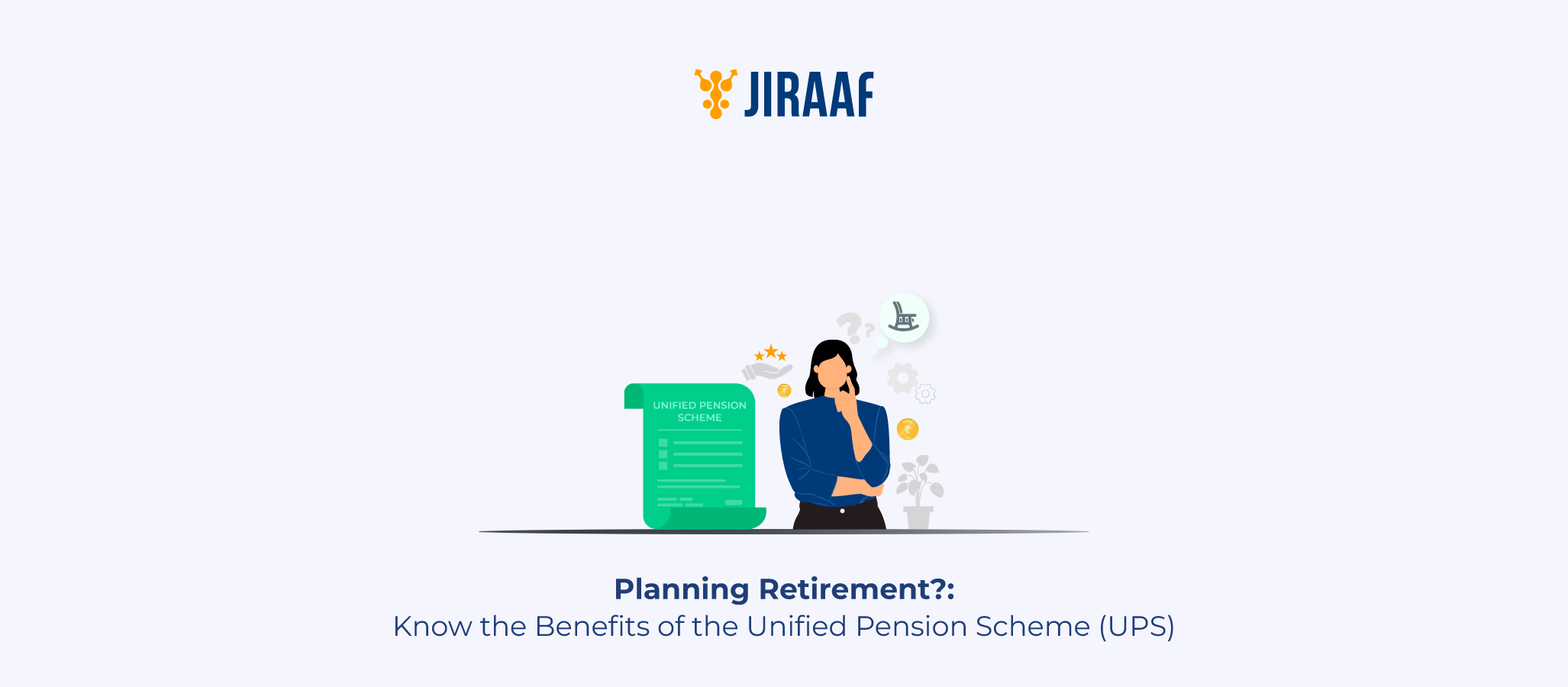The Indian retirement ecosystem is undergoing a transformation with the proposed Unified Pension Scheme (UPS). Aimed at simplifying and consolidating multiple existing retirement benefits, the UPS seeks to bring private and public sector workers under one umbrella pension system. This initiative, if rolled out widely, could become the backbone of India’s pension policy — combining the strengths of the National Pension System (NPS), Employees’ Provident Fund (EPF), and pension components like EPS and gratuity.
This blog explores what the Unified Pension Scheme is, its eligibility, benefits, pension returns, gratuity and contribution details, withdrawal rules, and the online application process. We also answer frequently asked questions to guide individuals planning for retirement through the UPS.
Unified Pension Scheme (UPS)
The Unified Pension Scheme (UPS) is a proposed all-in-one retirement framework that aims to merge various existing schemes — such as EPF, EPS, NPS, and gratuity — into a single integrated pension account for each employee.
It is designed to:
- Eliminate overlap and fragmentation between multiple pension schemes.
- Offer a centralised platform for contribution, recordkeeping, and payout.
- Bring portability, especially for individuals switching jobs across sectors.
The goal of UPS is to ensure every formal worker in India can access a minimum assured pension, with optional top-ups depending on contributions and tenure.
Who is Eligible for the Unified Pension Scheme?
Eligibility under UPS depends on employment type, age, and citizenship. The likely eligibility norms (based on government drafts and similar schemes) are:
1. Indian Citizenship
Only Indian citizens are eligible for UPS. This includes residents working in both public and private sectors.
2. Age Limit
- Entry Age: 18 to 55 years
- Minimum Contribution Period: 10 years
- Employees must join the scheme within the permissible age band to be eligible for lifetime pension benefits.
3. Employment Type
- Applicable to salaried employees across the government, private sector, and PSU jobs.
- Self-employed individuals may also be allowed under a voluntary mode, subject to contribution consistency.
4. Unorganised Sector
While NPS already caters to unorganised workers, UPS might extend its net to include informal workers by offering basic pension options via self-declared contributions or through aggregators.
Key Benefits and Features of the UPS
UPS offers a wide set of features designed for long-term retirement security:
1. Single Pension Account
Instead of managing multiple accounts (EPF, EPS, NPS), employees will have one unified pension account, simplifying contribution and tracking.
2. Gratuity Integration
UPS incorporates gratuity benefits within the pension calculation. Upon retirement, the accumulated gratuity may either be:
- Paid as a lump sum, or
- Adjusted to enhance the pension payout
3. Defined Contribution Structure
Like NPS, UPS is a defined contribution scheme, meaning both employer and employee contribute monthly. The corpus grows through market-linked returns.
4. Portability Across Jobs
No matter how many job switches you make, the same UPS account continues — a major upgrade over EPS or company-specific gratuity.
5. Annuity at Retirement
Upon retirement, the corpus is converted into a monthly pension (annuity) using government-approved annuity service providers (ASPs).
6. Transparent Statement Access
Contributors can view:
- Contribution history
- Current corpus
- Estimated monthly pension
Online dashboards, SMS alerts, and mobile apps will facilitate this.
Gratuity Integration and Contribution Details in UPS
UPS integrates traditional gratuity benefits and ensures consistent contribution flow from both employer and employee.
1. Employee Contribution
Typically, 10% to 12% of basic salary is deducted and routed to UPS.
2. Employer Contribution
Employers match the contribution, with a portion going towards pension and gratuity reserve.
3. Gratuity Calculation
As per UPS norms, gratuity may be calculated using the formula:
Gratuity = (15/26) × Last Drawn Salary × Years of Service
The accrued amount can be:
- Paid out directly post-retirement
- Or merged into the corpus for higher monthly pension
4. Vesting Period
Gratuity becomes payable only after completing 5 years of continuous service.
Expected Returns and Pension Payout under UPS
Returns under UPS are market-linked but regulated, ensuring steady growth without excessive volatility.
1. Investment Strategy
Contributions are invested in a mix of equities, government securities, and corporate bonds — similar to the NPS Tier-I account.
2. Estimated Returns
Expected return: 8–10% annually, depending on the chosen risk profile.
3. Pension Payout
At retirement:
- A portion of the corpus (e.g., 60%) may be withdrawn as a lump sum
- Remaining corpus purchases an annuity plan from an approved insurer
- Annuity yields a monthly pension for life
4. Pension Amount Example
For someone investing ₹5,000/month for 30 years:
- Corpus: ₹1.1–₹1.3 crore (at 9% CAGR)
- Pension: ₹30,000–₹40,000 per month (approx.)
Withdrawal Rules, Exit Conditions & Taxation
UPS is designed to support long-term retirement goals, so early withdrawals are restricted and taxed accordingly.
1. Exit Before Retirement (Premature)
- Allowed only in certain conditions (disability, critical illness, job loss)
- Subject to exit penalty or reduced annuity benefits
2. At Retirement (60+ Age)
- Can withdraw a lump sum (up to 60%)
- Remaining used for annuity
- Full exemption under Section 10(12A) likely, similar to NPS
3. Death Before Retirement
- Nominee receives accumulated corpus
- Can opt for annuity or full withdrawal
4. Tax Benefits
Likely UPS tax provisions include:
- Section 80C deduction on contribution (up to ₹1.5 lakh)
- Section 80CCD(1B) additional deduction for ₹50,000 (if UPS aligns with NPS)
- Tax-free corpus at maturity if withdrawn as pension
How to Apply for the Unified Pension Scheme Online?
The UPS will be managed through a centralised pension portal, likely under the PFRDA or a new pension regulator. Here’s how the application may work:
1. Registration Steps
- Visit the official UPS Portal (e.g., ups.gov.in)
- Register using Aadhaar and PAN
- Submit employment and salary details
- Choose contribution amount and frequency
- Upload KYC documents
2. Through Employer
- Employers integrate payroll with UPS
- Auto deduction and deposit to employee’s UPS account
- Employer dashboard to view compliance
3. Self-Employed or Voluntary Option
- Register individually via UPS platform or authorised financial institutions
- Set up recurring payment through bank mandate
4. Statement Access and Servicing
- Use login to track pension balance
- Download annual statement
- Raise grievances or update nominee details
Unified Pension Scheme vs NPS, EPF, and EPS
| Feature | Unified Pension Scheme (UPS) | NPS | EPF + EPS |
| Account Structure | One consolidated account | Tier-I & Tier-II | Two separate accounts |
| Employer Contribution | Yes | Optional (corporate model) | Yes |
| Portability | High | High | Limited (EPS linked to employer) |
| Tax Benefits | 80C + 80CCD(1B) likely | 80C + 80CCD(1B) | 80C |
| Gratuity Integration | Yes | No | No |
| Annuity Option | Mandatory at retirement | Mandatory (Tier-I) | EPS-based pension only |
| Investment Mode | Managed by PFRDA/UPS body | PFRDA governed | EPFO managed |
Conclusion
The Unified Pension Scheme (UPS) promises to be a landmark reform in India’s pension framework. By offering a consolidated retirement solution, it eliminates redundancy, improves portability, and ensures a more predictable post-retirement income.
It blends the structure of NPS with the coverage of EPF and the assurance of EPS while bringing gratuity and taxation under a unified interface. For working professionals, it can act as a comprehensive retirement vehicle, balancing flexibility, transparency, and security.
As the scheme rolls out, individuals and employers alike should understand its contours and evaluate how it fits into their long-term financial planning.
FAQs for Unified Pension Scheme (UPS)
Entry age is expected to be 18 years, with contributions allowed until 60.
Yes, contributions are expected to be eligible under Sections 80C and 80CCD(1B), similar to NPS.
Yes, the scheme is designed for both sectors, with seamless portability.
Gratuity benefits are built into the UPS corpus and used to enhance final pension payout or paid as a lump sum.
Early exit is allowed under special circumstances and may attract penalties or reduced annuity benefits.
Subscribers will be able to log into the UPS portal using Aadhaar/PAN and view real-time contribution statements.
Discover fixed income investments with Jiraaf, a SEBI registered online bonds platform that educates and brings access to a wide array of bonds. Sign up today to explore diversified fixed income investment opportunities to support your goal-based wealth creation journey. Start investing!



